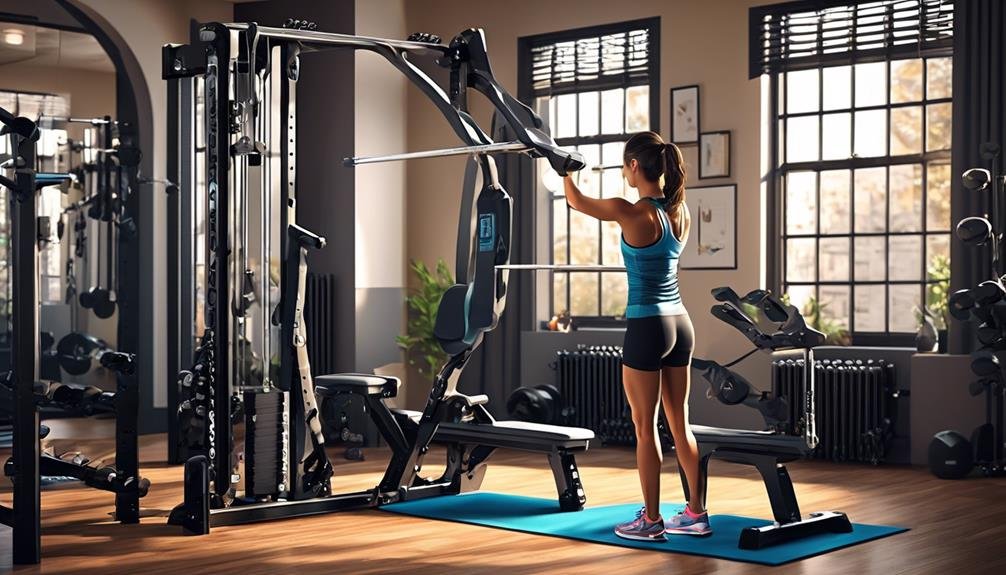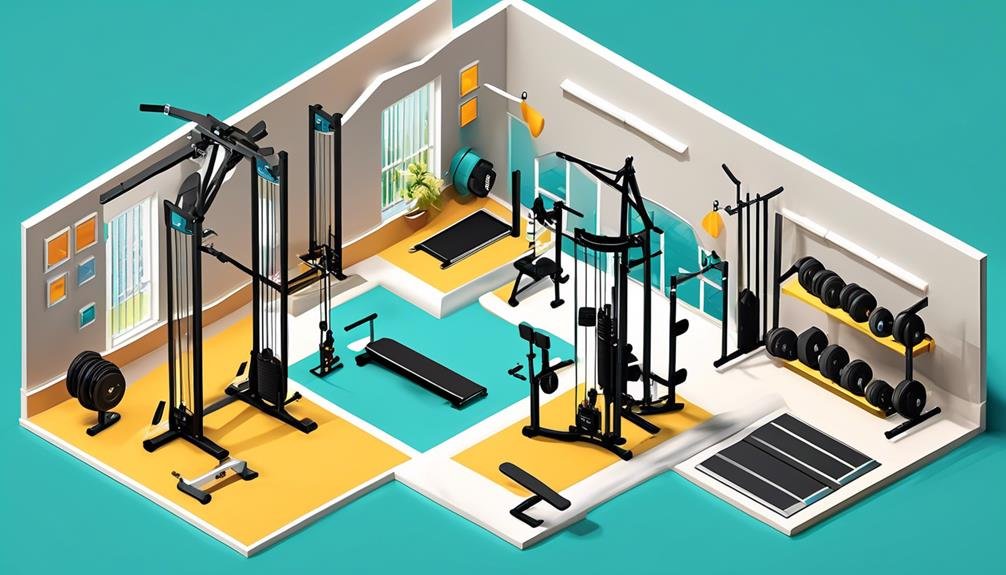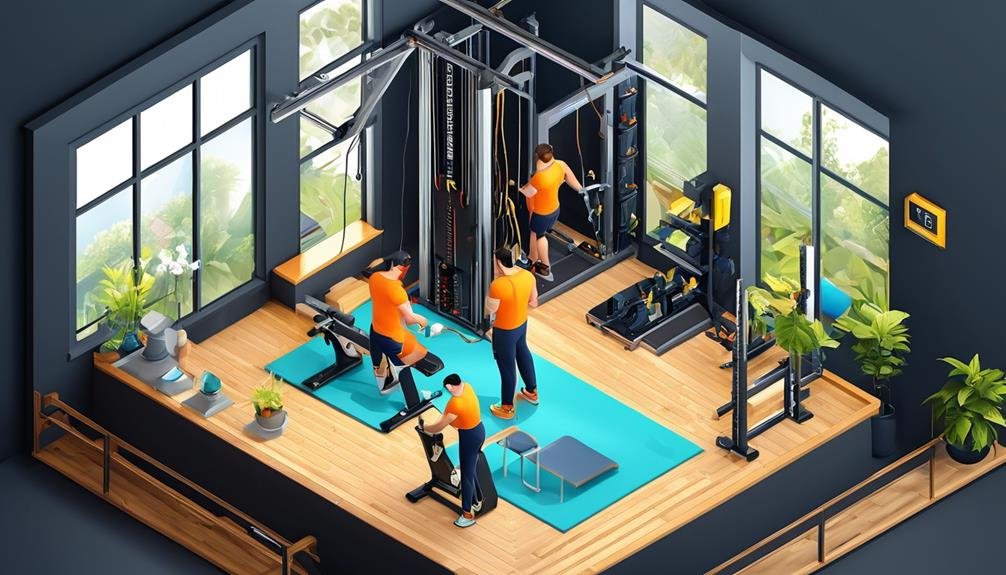Disclaimer: This content is for informational purposes only and does not replace professional medical advice, diagnosis, or treatment. Always consult a qualified healthcare provider before beginning any new exercise program.
So, you've decided to set up your own little fitness haven at home. No more sweaty gym equipment, no more judgmental stares from fellow gym-goers. But now you find yourself wondering, how can you truly measure your progress without the fancy equipment and expert trainers?
Well, fear not, because there are a variety of fitness tests that can help you benchmark your progress in the comfort of your own home. From strength tests to cardiovascular fitness tests, each one provides valuable insight into your overall fitness level.
But which tests should you focus on? Stay tuned, because we're about to reveal the key tests that will help you track your progress and reach your fitness goals.
Key Takeaways
- Strength tests such as the one-rep max test, push-up test, plank test, squat test, and pull-up test can be used to benchmark progress in a home gym and track improvements in specific exercises and muscle groups.
- Endurance tests like the Cooper Test, burpee test, step-up test, stair test, and shuttle run test can assess cardiovascular fitness and muscular endurance, providing insights into overall stamina and aerobic capacity.
- Flexibility tests such as the sit-and-reach test, shoulder flexibility test, trunk rotation test, hip flexor test, and calf flexibility test can help evaluate flexibility and range of motion, which are important for preventing injuries and improving performance.
- Body composition tests like the skinfold test, BIA, DXA, hydrostatic weighing, and Bod Pod can provide estimates of body fat percentage and body composition, helping individuals monitor changes in their physique over time.
Strength Tests
To evaluate your strength and track your progress in a home gym, you can perform a variety of fitness tests that will provide valuable insights into your physical capabilities.
One of the most common strength tests is the one-rep max (1RM) test. This test involves determining the maximum weight you can lift for a specific exercise, such as the bench press or squat. By knowing your 1RM, you can set realistic goals and track your strength gains over time.
Another effective strength test is the push-up test. This test measures the endurance and strength of your upper body, particularly the chest, shoulders, and triceps. To perform this test, start in a plank position and lower your body until your chest touches the ground, then push yourself back up. Count the number of push-ups you can do until exhaustion. This test is a great indicator of your overall upper body strength.
The plank test is another valuable strength test that targets your core muscles. To perform this test, assume a push-up position and hold it for as long as possible without letting your hips sag. This test measures your core stability and endurance.
Endurance Tests
Now let's shift our focus to endurance tests, which will further assess your physical capabilities in a home gym. Endurance is a crucial component of overall fitness, as it measures your body's ability to sustain prolonged physical activity. By incorporating endurance tests into your fitness routine, you can track your progress and identify areas for improvement.
One popular endurance test is the Cooper Test, which measures how far you can run in 12 minutes. This test not only evaluates your cardiovascular fitness but also provides an estimate of your aerobic capacity.
Another effective endurance test is the Burpee Test, where you perform as many burpees as possible in a set time frame, usually one minute. This test challenges your cardiovascular endurance, muscular strength, and overall stamina.
To assess your lower body endurance, consider the Step-Up Test. This test measures how many step-ups you can complete in a specific time, usually one minute. It targets your leg muscles and helps evaluate their endurance and strength.
Flexibility Tests

Flexibility tests are essential for evaluating your range of motion and assessing the health and functionality of your muscles and joints in a home gym. Being flexible isn't only important for your overall fitness, but it also helps prevent injuries and improves your performance in other exercises. There are several flexibility tests that you can incorporate into your home gym routine to track your progress.
One common flexibility test is the sit-and-reach test. This test measures the flexibility of your hamstrings and lower back. To perform this test, sit on the floor with your legs extended in front of you and reach forward as far as you can.
Another test is the shoulder flexibility test, which assesses the range of motion in your shoulders. To do this test, stand with your feet shoulder-width apart and bring one arm across your chest, then use the other arm to push it further across.
It's important to remember that flexibility isn't something that can be improved overnight. Consistent stretching and incorporating flexibility exercises into your workout routine will gradually increase your range of motion. By regularly performing these flexibility tests, you can track your progress and see how far you've come.
Cardiovascular Fitness Tests
As you continue to enhance your fitness in a home gym, it's crucial to assess your cardiovascular endurance through a series of comprehensive fitness tests. Cardiovascular fitness is an essential component of overall health and can significantly impact your ability to perform daily activities. By measuring your cardiovascular endurance, you can track your progress and set realistic goals to improve your fitness levels.
To help you understand the different cardiovascular fitness tests available, here is a table detailing four common tests:
| Test Name | Description | Benefits | Limitations |
|---|---|---|---|
| 1. 12-Minute Run/Walk Test | Measures how far you can run or walk in 12 minutes | Simple and easy to perform | May not accurately reflect your true cardiovascular fitness level |
| 2. Step Test | Measures heart rate recovery after stepping up and down a platform for a set time | Requires minimal equipment | Not suitable for individuals with balance or joint issues |
| 3. Rockport Walk Test | Measures how quickly you can walk one mile | Suitable for all fitness levels | Requires a track or measured distance |
| 4. VO2 Max Test | Measures the maximum amount of oxygen your body can utilize during exercise | Provides precise results | Requires specialized equipment and professional supervision |
Body Composition Tests

To accurately assess your body composition in a home gym, there are various tests available that can provide valuable insights into your overall fitness and health. Body composition tests are designed to measure the different components that make up your body, such as fat, muscle, and bone. These tests can help you determine the effectiveness of your workout routine and track your progress over time.
One commonly used body composition test is the skinfold test. This involves using calipers to measure the thickness of your skin folds at various sites on your body. The measurements are then used to estimate your body fat percentage.
Another popular test is bioelectrical impedance analysis (BIA), which uses a small electrical current to measure the resistance of your body tissues. This information is used to estimate your body fat percentage.
Other body composition tests include dual-energy X-ray absorptiometry (DXA), which uses X-ray technology to measure bone density and estimate body fat percentage, and hydrostatic weighing, which involves being weighed underwater to calculate body density and fat percentage.
Balance and Stability Tests
Now let's explore how you can assess your balance and stability in a home gym, building upon the valuable insights gained from body composition tests.
To effectively measure your balance and stability, consider incorporating the following tests into your home gym routine:
- Single Leg Stance: Stand on one leg for as long as possible, aiming for a stable and steady position. This test helps evaluate your ability to maintain balance on a single leg, which is crucial for various activities like walking, running, and sports.
- Bodyweight Squat: Perform a squat without any external weights, focusing on maintaining proper form and balance throughout the movement. This test assesses your ability to control your body's center of gravity and stability while performing a fundamental exercise.
- Yoga Tree Pose: Assume the tree pose by standing on one leg and placing the sole of the opposite foot against your inner thigh. Hold this position for as long as possible while maintaining steady balance. This test challenges your stability and requires concentration and control.
Frequently Asked Questions
What Are Some Common Mistakes to Avoid When Performing Strength Tests in a Home Gym?
When performing strength tests in a home gym, it's important to avoid common mistakes. Remember to use proper form, don't rush through exercises, and listen to your body to prevent injury and ensure accurate progress tracking.
How Can I Track My Progress and Set Goals for Endurance Tests in a Home Gym?
To track your progress and set goals for endurance tests in a home gym, start by choosing specific tests like timed runs or cycling distances. Regularly measure and record your performance to gauge improvement and adjust your goals accordingly.
Are There Any Specific Flexibility Tests That Can Be Easily Performed at Home Without Any Equipment?
There are several flexibility tests you can easily do at home without any equipment. These tests can help you track your progress and improve your flexibility over time.
Can Cardiovascular Fitness Tests Be Performed Without Using Traditional Gym Equipment Like Treadmills or Stationary Bikes?
You can definitely perform cardiovascular fitness tests at home without traditional gym equipment like treadmills or stationary bikes. There are exercises like jumping jacks, high knees, and burpees that can help measure your cardiovascular endurance.
Is It Necessary to Have Expensive Body Composition Measuring Devices to Accurately Assess Body Composition in a Home Gym Setting?
No, you don't need expensive body composition measuring devices to accurately assess body composition in a home gym. There are alternative methods available, such as skinfold measurements and bioelectrical impedance analysis, that can provide reliable results.
Conclusion
In conclusion, when it comes to benchmarking progress in a home gym, there are several fitness tests that can help you track your improvements.
Strength tests, endurance tests, flexibility tests, cardiovascular fitness tests, body composition tests, and balance and stability tests are all effective ways to measure your fitness level and monitor your progress over time.
By regularly performing these tests, you can stay motivated, set new goals, and continue to improve your overall fitness in the comfort of your own home.



